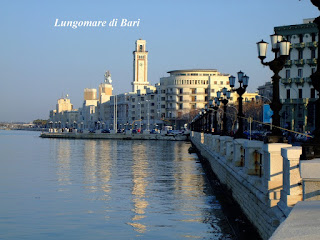Discovering the city of Bari part 1
Apulia has had many invaders from
different civilizations. They arrived from the sea to a land full of light,
scents and hospitable people. Greeks, Romans, Byzantines, Normans, Swabians and
Aragonese: people and cultures which have left their marks in these lands.
Times and travellers are different nowadays, but in our land, rich in charm and
culture, new ideas and ancient traditions live in harmony. Everyone arriving in
Apulia finds something familiar so that he feels at home.
Bari is a seaside town and the
old town overlooks
the sea front which is the longest in Italy. Proceeding along the seafront, we
suggest you to go southwards where you can discover the splendid buildings
built in the reign of Umberto Ist, such as the Kuursaal Santalucia Theatre in
Liberty style. Following the seafront you come to the Palace of the Provincial Council
with its Picture
Gallery, and the monumental palaces built during the Fascist epoch
such as the Albergo
delle Nazioni.
Along the
sea stretch two of the city’s Quarters: Madonnella and Japigia. The road south along
the sea leads to Torre a Mare, a small fishing town, whose name comes from an
ancient Angevin watch – tower, like many others along all the Apulian coast.
Following
the seafront northwards, you can find the Fiera del Levante. This is the seat of
important trade exhibitions such as the trade fair (in September), Orolevante,
Modalevante and Expolevante.
Following
the S.S. 16 you reach Palese and Santo Spirito, two pleasant small villages
with small harbours and many places where you can spend pleasant evenings. They
are worth visiting because they have preserved their own identity, so
picturesque and different from that of the main city.
The new part of Bari was founded by Joachim Murat in
1813, who laid the first stone just at the intersection between Corso Vittorio
Emanuele and Corso Cavour, which are the first two sides of the Murat Quarter.
Its boundary is marked by Via Quintino Sella that divides it from the Libertà
Quarter, whereas the railway in the boundary southwards. Beyond the station are
the working-class neighbourhoods of S. Pasquale, Picone and Carrassi, in the
Carrassi Quarter you can find the Russian Orthodox Church with its green domes,
dedicated to S. Nicola, and the Park of Largo 2 Giugno. The modern quarter of
Poggiofranco is just behind the park. A large ring road, that runs from south
to north, links it to the two quarters of S. Paolo and Stanic.
Source: Flash
Tour, printed in Italy on 2007.




No comments:
Post a Comment